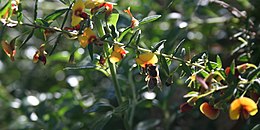Papilionaceous flower
The two keel petals are fused at their bases[3] or stuck together[4] to form a boat-shaped structure that encloses the essential flower organs,[5] namely the androecium and gynoecium.
Genera that conform to the latter morphology include Sophora, Anagyris, Cercis, Daviesia, Dillwynia, Gompholobium, Mirbelia and Pultenaea.
[7] Linnaeus remarked that they produce hardly any scent, but the flowers of Spanish broom, sweet pea, scorpion vetch, European yellow lupine, fava bean and various species of clover are notable exceptions.
In the valvular mechanism pollen is released repeatedly when pollinators unseal the upper rim of the keel petals, and force them downwards.
[1][10] Their keel petals are elongate, fused together and sometimes tubular to facilitate pollination by certain bird groups,[10] while secondary compounds in their nectar seem to repel bees.
[11] The false indigo genus, though belonging to the Faboideae, does not exhibit a papilionaceous corolla morphology, as it has only one petal per flower,[12] namely the banner.

